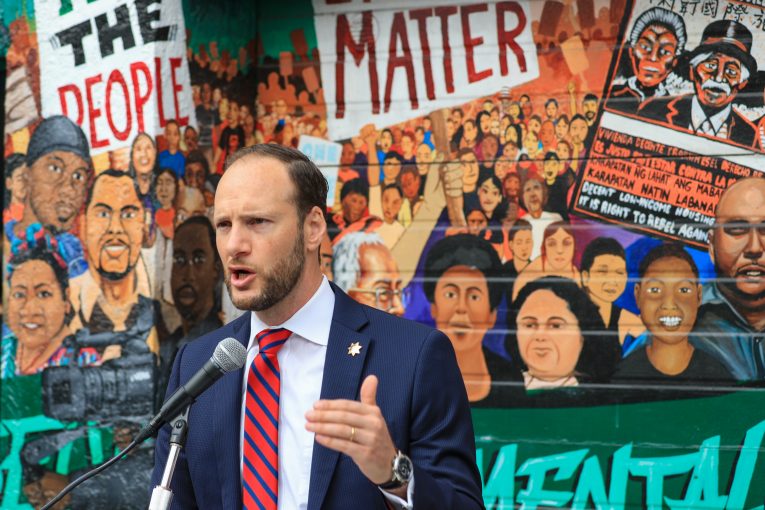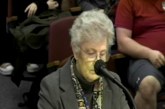
 By Darling Gonzalez
By Darling Gonzalez
SAN FRANCISCO, CA – San Francisco District Attorney Chesa Boudin is being “forced into recall election” on June 7, 2022, but this raises the question of how effective past DAs were at reducing crime rates, according to a news report.
On NBC Investigative Unit, Bigad Shaban noted Boudin and his supporters said that the recall is a “Republican backed, Republican funded, recall effort [similar to] the Gov. Newsom recall effort.”
The Investigative Unit reported that Boudin stated, “This has nothing to do with the facts or the real challenges our communities are facing…this has everything to do with disrespecting the will of the people.”
In response to the NBC Investigative Unit’s article, “SF District Attorney Chesa Boudin Officially Forced Into Recall Election Next June,” journalist and blogger, Matthew Yglesias tweeted, “She would never do it, but easy opportunity here for Kamala Harris to say the SF DA’s office was better when she was running it and become more popular.”
However, this tweet was quickly followed by a quote tweet hours later by criminal defense attorney David Menschel.
“Every single year that Kamala Harris was DA, violent crime in San Francisco was higher than it is now. And it was more punitive than it is now,” Menschel tweeted.
Supported by the Federal Bureau of Investigation (FBI) Crime Data Explorer, Harris’ term as DA in San Francisco between 2004 and 2010 shows a substantial increase of violent crime as reported by the San Francisco Police Dept.
The FBI Crime Data Explorer demonstrated an increase of crimes reported to the San Francisco Police Dept. from 5,757 in 2004 and up to 6,744 in 2008, two years before the end of Harris’ term as San Francisco DA.
On the other hand, during the start of his term in 2020, DA Boudin demonstrated a decline in crime with a low of 4,796 crimes reported to the SF Police Dept.
These reported crimes exhibit a decrease of 961 from when former DA Harris started her term and a total decrease of 1,948 reported crimes in 2008 compared to DA Boudin’s term in 2020.
Yet, DA Boudin and former DA Harris have incorporated similar tactics in their approach to crime in San Francisco, according to national reporting.
In The New Yorker’s article, “The Trial of Chesa Boudin,” Benjamin Wallace-Wells reported, “At times, Boudin has retreated to a less transformative approach, one that his predecessor Kamala Harris used when she spoke about being “smart on crime,” not tough on crime—that is, selective enforcement.”
NBC Investigative Unit mentioned that although there was a sizable amount of signatures for DA Boudin’s recall, some supporters have confidence in San Francisco voters’ rejection of the recall.
Julie Edwards, spokesperson for the group “Friends of Chesa Boudin Opposing the Recall,” stated, “We are confident San Francisco voters will reject this Republican-funded and endorsed effort…this recall effort is an attempt to reverse the reforms DA Boudin has enacted to keep us safe and make the criminal justice system fairer,” NBC Investigative Unit reported.
Boudin has told supporters that he has followed the promises of his campaign and has vowed to continue to fight the recall effort.







I’m thinking comparing someone to Kamala Harris and then saying they are better than Kamala Harris does them any political favors LOL.
Right, like it’s hard to beat Kamala’s 28% approval ratings.
DA article not VP fantasy land.
What the Hell is that?
???
David, you rose to the bait… now we’ll see a KO/DG departure from the asserted topic… just like yesterday, another thread… and we’ll see others “chumming (or, chiming) in”…
I google VP Fantasy Land for the heck of it and got hits on Mike Pence, Fantasy Island and for some reason Grey’s Anatomy.
Let’s all remember this is a “defense of Boudin” piece… lest we go astray from topic.
I have not formed an opinion of him, and am unlikely to….
Pray tell 😐
“Every single year that Kamala Harris was DA, violent crime in San Francisco was higher than it is now. And it was more punitive than it is now,” Menschel tweeted.
What’s gotten lost is even if crime has ticked up since the pandemic, we are still at the bottom of a very long downward curve.
All of the reports I’ve seen show that violent crime is rising significantly across the country.
Regardless, comparing any crime rate during a pandemic (with any other period) is what some might (politely) call a “lie”, regarding any particular conclusion regarding the effectiveness of a D.A.
https://www.theatlantic.com/ideas/archive/2021/09/america-having-violence-wave-not-crime-wave/620234/
And in San Francisco, some people don’t even bother reporting property crime anymore.
https://californiaglobe.com/articles/san-francisco-a-city-in-denial-about-crime-and-police/
By the way, what does that sign in the mural (in back of Boudin) say, again?
I patted a guy’s van window in SF who was blocking the bike lane. Unknown to me he followed me in traffic for over a mile and then confronted me and physically tried to push me over. I tried to report the assault to officers I saw who wouldn’t take a report (I had a license) and then tried to call it in when I got to Davis and was told I had to go live to a police station. I’m not one to give up on being assaulted, but going back to San Francisco to report the crime was a bit much. I’d gladly go if it went to trial, but just to report the crime? So yeah, maybe a lot goes unreported.
“So yeah, maybe a lot goes unreported.”
I agree – a lot goes unreported. Probably everywhere. But that’s why we look at crime trends and macro-level data because generally unreported rates should be fairly constant over time. And if so if you see reported crime falling, the only way that you would have actual crime rise is if the unreported crime rates went up while the reported crimes were going down. Is that possible? Maybe, but it seems unlikely.
Evidence for that?
Also, the definition/category of crime is changing, as demonstrated by the change in the dollar value of stolen items, the legalization of outdoor encampments, blocking of freeways, riots, etc.
I have increasingly heard reports that (even in Davis), retail and grocery stores have their hands tied, when thieves simply walk out with product in hand. And that the police also won’t do anything about that, at all.
How’s those catalytic converter thefts going, e.g., in the Bay Area? Has that also become an issue in Davis?
Have you heard about those victims (and yes, that is the right word) who have been shot when confronting catalytic converter thieves?
My comment is speculation based on known data. If you want to argue that the data is wrong, that’s fine. But you would need to show evidence that unreported crime is rising fairly rapidly while reported crime is not. I’ve seen nothing to suggest that’s the case.
As you noted, your comment is based upon speculation.
How would you respond to the other comments I just made? Again, there are facts I just listed.
https://www.wsj.com/articles/san-francisco-shoplifters-theft-walgreens-decriminalized-11634678239
I’d suggest that you take off your “advocating glasses” once in a while, and stop pretending that facts support what you claim.
One thing to do – let’s look at a bigger picture.
One thing we know isn’t going to get unreported – murder.
Murders in SF are 47 this year. 43 last year at this time. That’s an increase of 9.3%. On the other hand, the statewide murder rate went up 31 percent this year over last year. Oakland across the bay set a new record 100 as of September 21. They have a much faster increase over last year – more than 40 percent. Their DA is a traditional DA.
Also why is your opinion piece better than mine?
https://www.sfchronicle.com/sf/article/Here-s-what-the-people-behind-the-Chesa-Boudin-16616934.php
Some probably do go unreported (e.g., “missing” people, or those who are not “missed”).
47 as of what date? Again, we’re in a pandemic.
You’re trying to make this about a particular D.A., while I am looking at a broader picture. Criminals are able to travel, by the way. (Some come from Oakland into San Francisco, and vice-versa.)
The real question you should be asking is whether or not keeping criminals out of prison will increase crime, and whether or not whatever you’re proposing would be as effective in doing so. You don’t have enough data to draw any conclusion regarding that.
As of 11/14. We were in a pandemic last year too. The rest of the country is in a pandemic as well. That’s why we use time and place comparison points when analyzing data.
Again, not enough data to support any conclusion. San Francisco is not an island that you can examine that way.
However, have you ever considered the possibility that criminals are getting “priced out” of San Francisco? Wholesale destruction of lower-income neighborhoods (such as the Western Addition) years ago via redevelopment agencies? Entire neighborhoods (such as the Mission) becoming increasingly gentrified?
One thing that I suspect is occurring is that places like San Francisco become a magnet for property crimes (and related assaults) based upon “impression” (in regard to lack of enforcement, changes in law, etc.). But that the criminals don’t necessarily live there.
Meanwhile, places like Pittsburgh, Antioch, South and North Sacramento, and Stockton become increasingly dangerous?
So we’ve gone from Boudin is a big problem to trying to argue away data. I don’t have a conclusion other than the data so far doesn’t support the narrative put forward by Boudin’s critics.
Keep in mind, we actually control for those contextual factors when we compare SF year 1 to SF year 2. We would expect the baseline murder rate to be lower in SF than Oakland and it is far lower. But the rate of increase is a function of other factors and the reason you compare the rate of increase to elsewhere is to see if local policies might be influential – that’s not conclusive, but again, the data we have doesn’t support the narrative that has emerged.
My comments (today) weren’t about Boudin. However, he is a symbol of the “new approach” toward crime, for some. This is not limited to San Francisco.
I also did not try to “argue away” data. Your data does not show anything conclusive regarding Boudin. Again, San Francisco is not an island that you can examine that way.
Gentrification and rising housing prices are probably the best explanation regarding any (positive) change in crime rates, for San Francisco.
Davis is (kind of) like that, as well. Criminals live in other communities, and come to Davis to victimize it. Not too many catalytic converter thieves are buying (or even renting) houses in Davis, most likely. (Might be homeless, however.)
Some homeless people in Davis are likely engaging in crimes such as shoplifting. And, they know that they won’t be effectively prosecuted.
I have heard reports, for example, that some people living in The Cannery were victimized (property crime) by those living by the railroad tracks. In other words, directly witnessed. And that the police weren’t interested in investigating that.
” Your data does not show anything conclusive regarding Boudin. ”
It’s almost like you haven’t read my comments as I have stated several times that the only thing I can conclude from the data is that it currently doesn’t support the narrative. We don’t have enough data, we don’t have a rigorous data analysis, but the data we do have isn’t supportive of the narrative. In other words – if you showed me the data that we have and asked if I thought the DA was in trouble, I would say no. Or if you asked if the data showed that Boudin’s policies were working, I would say, it’s inconclusive. That’s what we have. Everything else is just narrative.
In Davis I’ve had my patio furniture stolen right off my patio which was worth several hundreds of dollars. I didn’t bother reporting it.
https://www.sfgate.com/bayarea/article/catalytic-converter-thefts-rampant-16589060.php
So yeah, I (for one) am less-concerned about the skin color of those committing crimes (or the skin color of their victims), than the fact that crime is occurring. Am I in the “minority” regarding that?
Davis also has huge amounts of catalytic converter thefts. They are impossible to catch unless you get the actual operation. You should talk to Pytel about it, interesting stuff.
I hope we never hear about the 5 comment limit, as ‘modified’ again… unevenly applied…
When David is engaging, I tend to leave it alone. Also, Bill, I’m not on here 24/7, so frequently comments get ahead of me. You know what would really help? I’m going to shout now.
YOU GUYS CAN COUNT. JUST STOP AT FIVE COMMENTS!
And honestly I don’t really need your ongoing input on this topic. Ok?
Real or imagined, if it’s perceived, it is as good as real:
Fed Up With Crime SF Residents Hire Private Security
https://www.youtube.com/watch?v=vPWct6YcgIE
I doubt articles in a Davis blog will change perceptions like those, nor those of the young SF professionals I had dinner with last Thursday.
Alan, Bill, Ron O, and Keith cannot comment on this topic any more today.
It’s a new day!
Fox News has a short documentary interviewing people in San Francisco about the crime wave:
San Francisco locals react to rampant shoplifting, break-ins
https://www.youtube.com/watch?v=BU6o2MIuMQc
Pretty much lines up with what people I know in the City are saying. Not saying it’s all Chesa’s fault. But as the symbol that represents the crime surge, real or imagined . . . well . . .
That’s the problem – real or imagined? And once people believe there is a crime wave, every anecdote will feed to that and they will discount evidence to the contrary.